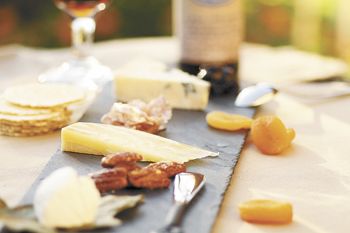Grated Gratitude

By Christine Hyatt
Thanksgiving is the quintessential American holiday. Coming together with family and friends over a feast and giving thanks for the bounty in our lives is an anticipated event each year.
The conspicuous lack of cheese on the ‘Turkey Day’ menu probably goes unnoticed by most, but as someone who views much of my life through the ‘lens’ of cheese — whether writing about it, photographing it, talking about it or savoring it — I feel that it’s high time to challenge the cheese-free Thanksgiving feast.
Considering the myriad ways great cheese can positively affect us by elevating our eating experience and impact our communities and our overall food system, there truly is much to be thankful for making it the perfect addition to our harvest celebrations.
Fine cheese is inherently a celebratory food: It provides a genuine taste experience that connects you more deeply with your sensory experience. It also serves as a direct connection to the land, animals, farmers and artisans who participate in its creation.
At a time when most food is ‘fast’ and ‘processed’ at faceless factories, the Thanskgiving table is an ideal place to reflect our highest ideals. To me, food produced with reverence and passion is the perfect launching point for that connection.
Featuring American-made products crafted by artisan and farmstead producers — from your local community, if available — is an easy way to honor the people who do the hard work required day-in and day-out to make delicious and satisfying cheese. They represent the finest aspects of the American food system and a creative, robust and growing segment of small business in America.
In an economic climate filled with stories of outsourcing, downsizing and cutbacks, in such an environment of scarcity and fear, I have such admiration for the number of people who jump into this business out of love, passion, dedication and a desire to create something good. It’s clear they aren’t doing it as a path to early retirement. As the adage in the wine industry goes: “Want to make a million dollars in wine? Start with $2 million.” The same holds true for cheese.
We can learn a lot about ourselves when we look at our food system. Certainly larger commodity producers are and will always be a necessary part of that equation. Through the economics of scale, they capture the lion’s share of the market and feed our country efficiently and effectively. They produce nutrient-dense products that feed a population that is, by necessity, more interested in ‘value’ foods today than just a few years ago.
Large producers process vast quantities of milk into mind-boggling volumes of cheese every day. Often, this cheese is quite good, but when it comes from farmer-owned co-ops like Tillamook, which provides high quality products in a way that supports local communities, everyone wins.
When we know who produces our food, we can ask them ‘how’ and ‘why’ certain business decisions are made in regard to herd management, environmental standards, community involvement, etc.
So much of our recent national dialogue has focused on how to rebuild our foundering economy, job creation and restoring some level of hope. Not to sound Pollyanna-ish, but I do believe that American cheese is part of the solution in some small way.
American craft cheeses present a value proposition that must not be overlooked. These products are an affordable luxury, bringing enormous satisfaction in small quantities. It is the antidote to the pervasive super-size fast-food mentality.
Savoring good food reconnects and grounds us, and opens up understanding of the wider food system. This is an especially important prospect as Congress prepares to consider the 2012 Farm Bill.
Active, aware and engaged consumers are absolutely the key to making policy that supports local, sustainable, job-creating businesses rather than corporate agriculture whose systems often overlook what’s best for local communities and consumers.
Smaller cheese-producing operations practice more sustainable agriculture methods with manageable herd sizes. They often source dairy locally, at a time when many dairies are failing because it costs more to produce fluid milk than its market value. Many cheesemaking operations emerged when multi-generation dairy farms looked to value-added product using their number one resource: great milk.
This is the make-it-or-break-it time for cheesemakers. They have spent the growing season hard at work every day with the hope that their sales now will support that effort and sustain them into future years. Now it’s time for us consumers to put our money where our mouths are.
I recognize these are not everyday cheeses for most of us. As the mother of two young boys, I know that fancy cheese is something we enjoy in moderation. But appreciating these products and what they represent in the bigger picture is one small way we can all be part of building a better food system.
Oregon has done a remarkable job at building a system that supports and promotes local cheesemaking and has seen much success in getting ‘Brand Oregon’ noticed beyond the state’s borders. Oregon cheeses are in wide acclaim at foodie markets as diverse as New York, San Francisco, London, Paris and even cities in Asia. The opportunities for this type of food production to drive exports for the state’s economy will increase as long as people embrace the value of the product, beyond the price tag.
My hope and challenge for you, dear readers, is that you might make room on your holiday table this year for cheeses from Oregon, the Northwest and the U.S. As you share these special products with friends and family, you can feel good, knowing you are contributing to a small-but-thriving sector of our economy.










